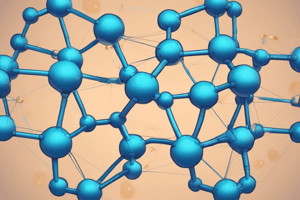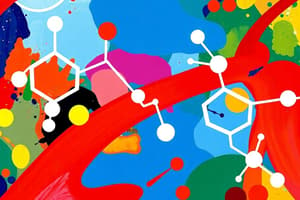Podcast
Questions and Answers
What is activation energy?
What is activation energy?
Activation energy is the minimum energy required for a chemical reaction to occur, related to the strength and number of existing chemical bonds.
Which factors can affect the rate of a chemical reaction?
Which factors can affect the rate of a chemical reaction?
- Temperature (correct)
- Concentration (correct)
- Presence of a catalyst (correct)
- Surface area (correct)
- Pressure (correct)
Activation energy influences the rate of a chemical reaction.
Activation energy influences the rate of a chemical reaction.
True (A)
Activation energy is the minimum energy required for a chemical reaction to occur, and is influenced by the strength and number of existing chemical _ _ _ _ _.
Activation energy is the minimum energy required for a chemical reaction to occur, and is influenced by the strength and number of existing chemical _ _ _ _ _.
According to VSEPR theory, what are the approximate bond angles for the following molecular shapes: linear, bent, trigonal planar, tetrahedral, and pyramidal?
According to VSEPR theory, what are the approximate bond angles for the following molecular shapes: linear, bent, trigonal planar, tetrahedral, and pyramidal?
What are the primary types of intermolecular forces found within molecular covalent substances?
What are the primary types of intermolecular forces found within molecular covalent substances?
Temperature changes have no effect on the solubility of most gases.
Temperature changes have no effect on the solubility of most gases.
PH is dependent on the concentration of _______ ions in a solution.
PH is dependent on the concentration of _______ ions in a solution.
What is activation energy (Ea) related to in a chemical reaction?
What is activation energy (Ea) related to in a chemical reaction?
What do catalysts, including enzymes and metal nanoparticles, affect in chemical reactions?
What do catalysts, including enzymes and metal nanoparticles, affect in chemical reactions?
Activation energy (Ea) is the minimum energy required for a chemical reaction to occur and is related to the strength and number of the existing ______ bonds.
Activation energy (Ea) is the minimum energy required for a chemical reaction to occur and is related to the strength and number of the existing ______ bonds.
What theory is used to predict and explain the shapes of molecules?
What theory is used to predict and explain the shapes of molecules?
Which bond angles should be covered when applying VSEPR theory?
Which bond angles should be covered when applying VSEPR theory?
What are the three types of intermolecular forces mentioned in the content?
What are the three types of intermolecular forces mentioned in the content?
Molarity = [Blank].
Molarity = [Blank].
Most gases become more soluble as the solvent temperature increases.
Most gases become more soluble as the solvent temperature increases.
Match the following properties with their effects on solubility:
Match the following properties with their effects on solubility:
What is pH dependent on in a solution?
What is pH dependent on in a solution?
Flashcards are hidden until you start studying
Study Notes
Topic 1: Intermolecular Forces and Gases
- Apply VSEPR theory to predict, draw, and explain molecular shapes
- Use molecular shape, symmetry, and electronegativity to explain and predict molecular polarity
- Explain the relationship between observable properties (vapour pressure, melting point, boiling point, and solubility) and intermolecular forces (dispersion forces, dipole-dipole attractions, and hydrogen bonding)
- Construct 3D models of linear, bent, trigonal planar, tetrahedral, and pyramidal molecules
Topic 2: Aqueous Solutions and Acidity
- Understand the unique properties of water (boiling point, density, surface tension, and ability to act as a solvent) due to its molecular shape and hydrogen bonding
- Distinguish between solute, solvent, solution, and concentration
- Recall that concentration can be represented in various ways (moles per litre, mass per litre, or parts per million)
- Distinguish between unsaturated, saturated, and supersaturated solutions
- Apply solubility rules to determine products of reactions and predict precipitate formation
- Determine the presence of specific ions in solutions based on evidence from chemical reactions
- Construct and use ionic formulas, chemical formulas, and chemical equations to communicate conceptual understanding
Topic 3: Rates of Chemical Reactions
- Explain how varying conditions (temperature, surface area, pressure, concentration, and catalyst presence) affect the rate of chemical reactions
- Use collision theory to explain and predict the effect of concentration, temperature, pressure, and surface area on reaction rates
- Construct and explain Maxwell-Boltzmann distribution curves for reactions with and without catalysts
- Recognize that activation energy is the minimum energy required for a chemical reaction to occur
- Sketch and use energy profile diagrams to represent enthalpy changes and activation energy associated with chemical reactions
- Explain how catalysts (including enzymes and metal nanoparticles) affect reaction rates by providing an alternative reaction pathway with a reduced activation energy
- Use mathematical representations to calculate the rate of chemical reactions by measuring the rate of formation of products or the depletion of reactants
Topic 1: Intermolecular Forces and Gases
- Apply VSEPR theory to predict, draw, and explain molecular shapes
- Use molecular shape, symmetry, and electronegativity to explain and predict molecular polarity
- Explain the relationship between observable properties (vapour pressure, melting point, boiling point, and solubility) and intermolecular forces (dispersion forces, dipole-dipole attractions, and hydrogen bonding)
- Construct 3D models of linear, bent, trigonal planar, tetrahedral, and pyramidal molecules
Topic 2: Aqueous Solutions and Acidity
- Understand the unique properties of water (boiling point, density, surface tension, and ability to act as a solvent) due to its molecular shape and hydrogen bonding
- Distinguish between solute, solvent, solution, and concentration
- Recall that concentration can be represented in various ways (moles per litre, mass per litre, or parts per million)
- Distinguish between unsaturated, saturated, and supersaturated solutions
- Apply solubility rules to determine products of reactions and predict precipitate formation
- Determine the presence of specific ions in solutions based on evidence from chemical reactions
- Construct and use ionic formulas, chemical formulas, and chemical equations to communicate conceptual understanding
Topic 3: Rates of Chemical Reactions
- Explain how varying conditions (temperature, surface area, pressure, concentration, and catalyst presence) affect the rate of chemical reactions
- Use collision theory to explain and predict the effect of concentration, temperature, pressure, and surface area on reaction rates
- Construct and explain Maxwell-Boltzmann distribution curves for reactions with and without catalysts
- Recognize that activation energy is the minimum energy required for a chemical reaction to occur
- Sketch and use energy profile diagrams to represent enthalpy changes and activation energy associated with chemical reactions
- Explain how catalysts (including enzymes and metal nanoparticles) affect reaction rates by providing an alternative reaction pathway with a reduced activation energy
- Use mathematical representations to calculate the rate of chemical reactions by measuring the rate of formation of products or the depletion of reactants
Studying That Suits You
Use AI to generate personalized quizzes and flashcards to suit your learning preferences.



